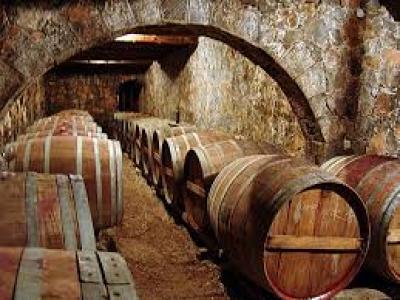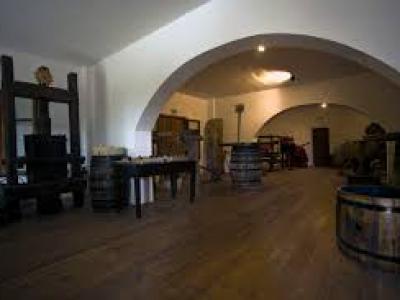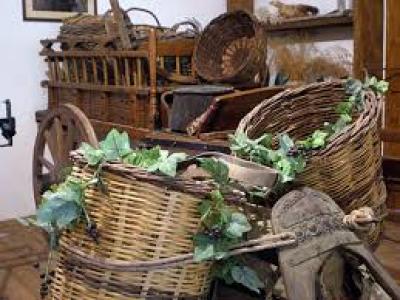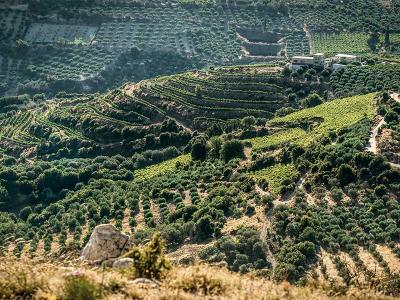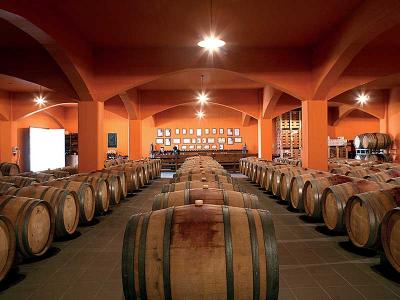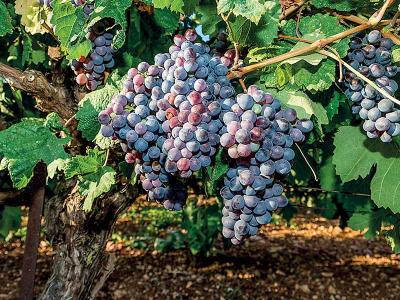History of Wine in Crete

The history
Of the vineyard can be traced back to the furthest reaches of time. Seeds of wild vines have even been found in caves inhabited by prehistoric nomadic tribes. Before the ice age, the vine flourished in the polar zone. Glaciers, however, limited its spreading and pushed various species of wild vines towards warmer zones, such as central and eastern Asia, central and southern Europe, but also the greater area of south Caucasus. That is the birthplace of Vitis vinifera, the wine-bearing vine, several varieties of which are almost exclusively being cultivated today. Phoenicians were renowned winemakers, but also merchants: Phoenician wine amphorae have been found in every region of eastern and central Mediterranean. One of the first great centers of maritime wine trading was Tyros. Greeks developed winery to a great extent, almost establishing a monopoly in the market for centuries. They acquired knowledge of wine probably when they first settled at their current land. It is not certain whom they learned the art of winery from, but, according to one of the most prevalent theories, they learned it from the eastern people (Phoenicians or Egyptians), with whom the Greeks, especially the Minoans, had developed commercial relations.
Wine as a core element of the first. European civilization
However, the history of wine in Crete and its bonds with the island have deeper roots, dating even further back than the Homeric epics.
One hundred years have passed since internationally-acclaimed archaeologist Sir Arthur Evans brought to light the miracle of the Minoan Civilization in Crete. At the palace of Knossos, the oldest architectural monument in Europe, luxurious four-storey buildings were found, with services the rest of Europe acquired several thousands of years later. Evans was so impressed by the living standards of ancient Cretans he very often praised them in front-page articles in the world’s most popular journals. The multicolored wall-paintings in Minoan Palaces depict a life full of creativity, good taste and in complete harmony with the natural environment.
Minoans cultivated their land and tasted what it so generously offered. Hundreds of tablets discovered by archaeologists show a flourishing economy with agricultural, livestock-raising and commercial activities. The main products Cretans successfully cultivated and traded were olive oil, cereals and wine.
The vine has known around 4000 years of systematic cultivation in Crete! No wonder that the oldest wine-press (3500 years old) was found in the region of Vathipetro. Homer informs us that, at his time, Cretan wines were renowned throughout the known world. Apart from the 3500-year-old wine-press, impressive amphorae, vast underground wine storage facilities and relevant drawings in all Minoan Palaces provide evidence not only of wine’s central role in the life of the island, but also of the sophistication of the Minoans’ know-how.
Cretan wine in the 20th century
Crete was liberated from the Ottoman rule in the late 19th century. The new and fairly progressive independent administration of the island promoted the restructuring and updating of agricultural production with all its might. The wheels of wine production thus started turning anew. In the international fair held at Hania at the beginning of the 20th century with the aim of promoting new Cretan products to the markets of the West, 18 winemakers were awarded prizes for the quality of their wines.
In 1913, Crete was annexed to the Greek state. But Greece’s tumultuous history over the next decades, with one war after the other, did not favour exports, affecting wine in particular. Despite adverse conditions, however, Cretan winemaking tradition survived all these hard years, owing to its core unit: the family. To this day, many modern companies producing and exporting wines, which are becoming all the more popular in foreign markets and are awarded prizes in international competitions, come from families of large and medium landowners, who kept both tradition and their love of wine alive all these years.
In modern reality, Cretan wine has long attracted the attention of and is being increasingly preferred by the general public. Cretan wines are a valuable heritage of traditional varieties, in complete harmony with the island’s climate. The great number of local varieties, the diversity and uniqueness of various wine regions, but also the long Cretan wine tradition form the foundation of Cretan wine’s high quality standing and ongoing growth.
This tradition, however, would not bear fruit without knowledge and technology. Cretan winemakers took recent advancements, but also the consumers’ preferences, seriously into account. This is largely due to the existence of a new generation of winemakers, enologists, viticulturists, etc. who are trying to improve all aspects of Cretan wine with knowledge, vision, and passion.
New varieties are being tested, and new aromas and flavors are emerging, presenting the consumer with fine wines, which can satisfy all tastes and needs. Making good use of traditional vine varieties and age-old experience, modern wine producers in Crete have managed to elevate Cretan wine to its rightful position.
Glossary of wine tourism in Crete. A brief summary of local varieties
Dafni: The various aromas of Dafni bring to mind the well-known plant dafni (laurel), hence its name. Quite a remarkable variety, whose scarcity is matched by the rarity of its taste character.
Kariki: Line of vines in a linear vineyard.
Kofa: Tall woven basket (with a capacity of around 50 kg) used to carry grapes from the vineyard to the wine-press.
Kotsifali: Soft and mellow, full of plum fragrances, the fleshy Kotsifali can be described as the Cretan equivalent of Merlot. Jointly responsible for the wonderful PDO Peza and Archanes wines.
Kourmoula: Grapevine plant.
Koutsokorfizo: To cut the tip of vine shoots.
Ksefilizo: To remove leaves from the base of the vine or entire shoots with no fruit.
Liatiko: Excellent red variety which may be lacking in color, but offers unique sweetness and character. The mind-blowing sweet and dry PDO Sitia and Dafnes wines are indisputable proof.
Logado: Vineyard with various local varieties.
Malvazia di Candia: This special clone of the aromatic Malvazia has returned to the fore, offering a real scented bouquet to both sweet and dry wines of the island.
Mantilari: Wild and untamed like the Cretan land and its people, Mantilari is considered to be the king of native red varieties. This is where the PDO (Protected Designation of Origin) Peza and Archanes wines draw their strength from.
Muscat of Spina: This clone of Muscat is a small-grape treasure. In fact, its thin skin skyrockets the fine character of the dry wines it offers.
Plyto: Yet another variety recently saved from extinction, Plyto completes the mosaic of Cretan aromas and tastes with its refreshing acidity, its lemon scent and its lightness.
Romeiko: A particularly resistant variety which gives lively red wines with high alcohol content, average acidity and variable color – due to the distinctive variegated grapes growing on the numerous branches of the plant. The traditional wine Marouvas, which resembles sherry, is made out of this variety.
Thrapsathiri: A variety grown everywhere in Crete, offering balanced wines, rich in flavor. This is where the white PDO Sitia wines draw their particular taste from.
Tsaprazi: Saw-like, crescent-shaped folding knife with a wooden handle, used in vine-harvesting.
Vidiano: Unique apricot aroma, rich body, transfixing creamy taste. These elements make Vidiano the rising diva of the Cretan vineyard and justify its qualifying as Greece’s Viogner!
Vilana: The island’s white star, Vilana, makes an appearance in the PDO Peza or Sitia wines with its fascinating fine aroma, its light taste and its refreshing lemon-scented acidity.
